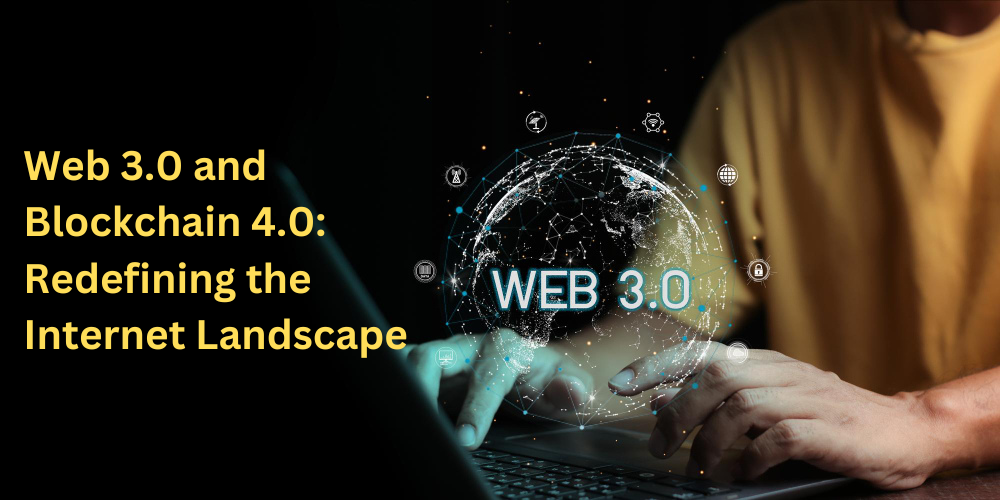
A hierarchical shift in the digital ecosystem is coming soon, and it is propelled by Web 3.0 and Blockchain 4.0. Interaction is being redefined as people embrace a new free world where control is shared, ownership is paramount, privacy is guaranteed, and data is more fluid, enabling broader web usage.
Individuals are being encouraged by Web 3.0 since it enables them to own their data and digital identities instead of being under the regime of data monopolization, like in the case of Web 2.0. At the same time, Blockchain 4.0 promises breakthroughs in scalability and real-time processing while incorporating new trends such as AI and IoT to promote the growth of decentralized applications (dApps).
In this blog, we will discuss the evolution of Web 3.0 and the benefits brought by Blockchain 4.0 technologies with a focus on key internet changes, characteristics, advantages, real-life scenarios, and features of the technologies. The significance of Web3 Development Companies for businesses in this digital age and hiring competent web3 developers will also be discussed. Let’s delve further into how the internet evolves and its impact on both users and organizations.
Introducing Web 3.0
Often described as a phenomenon, Web 3.0 is a game changer in terms of how people use and interact with the web. It shifts its focus on users’ experiences from dependence on centralized entities to users themselves. It provides users with features like greater privacy and stronger security, as well as authentic and self-managed digital assets, among other things.
Technological Foundations
Advanced technologies like blockchain, which ensures secure and transparent transactions, are the pillar of Web 3.0. Also, AI and machine learning help in the user experience through content suggestions/recommendations. Not to mention how the IoT elevates this ecosystem by connecting many devices together, allowing for efficient interactions across different platforms.
Comparison with Previous Web Generations
To grasp the concept of Web 3.0, one has to consider the history of web development and the progressive attainment of previous webs. The Internet of Documents, known as Web 1.0, consisted of simple static web pages with limited interaction, whereas the 2.0 ‘Web of People’ enhanced user interaction but with data lock-in issues and control to be dominated by large organizations. Web 3.0 is, therefore, geared towards more user empowerment over the centralized power structure.
The Rise of Blockchain 4. What is Blockchain 4.0?
Blockchain 4.0 is the most recent advancement in blockchain technology, which focuses more on enhancing scalability, ensuring interoperability, and increasing the speed of real-time data. This iteration surpasses performing cryptocurrency transactions by opening up a wide array of applications across industries, performing the functions that were a limitation in earlier versions of the blockchain. Integration with Emerging Technologies Integration with AI and IO while scaling up a blockchain network is a feature that is of paramount importance to Blockchain 4.0. The combined effect of this makes for a more advanced contract as well as automated processes, which improve decision-making as well as performance in general. Then, IoT-connected devices are able to communicate in a blockchain ecosystem, creating a more interconnected world that is agile and intelligent by design. Real-world Applications Then, in what ways is Blockchain 4.0 applied to real-life situations? In the financial sphere, DeFi protocols allow a wider pool of users to access the DeFi systems without an intermediary. Blockchain also permits secure but private exchange of patient databases across multiple healthcare facilities. In SCM, it increases the visibility and tracking of various products, enabling the owner to monitor the journey of the goods from production to the buyer. In conclusion, The capabilities of blockchain technology have been advanced by Blockchain 4.0, which is a game changer as it opens doors to newer solutions that deal with today’s issues in several industries.
Advantages of Web 3.0 and Blockchain 4.0: Technological Developments and User Empowerment
- Increased Security and Privacy
Security and privacy concerns are among the most impactful challenges of the online world, and Web 3.0 and Blockchain 4.0 offer a solution to such problems. These technologies implement a decentralized network, which lowers the impact of data breaches and intrusions. Users have a higher level of control of their private data and are thus able to choose the parties permitted to their private data and under which conditions, creating a safer online world.
- User Control and Possession
Web 3.0 changes the narrative of users being passive consumers to one of the active participants and that of endorsement alone but even having ownership over one’s digital presence. Unlike the older web models in which data ownership resides in one authority, web 3.0 gives data ownership back to users and allows them to take control of their data using decentralized technology. This transformation also improves the autonomy and independence of users while making them more willing to engage in the digital economy as they can earn money off of their data or their activities.
- Interoperability Across Platforms
Blockchain 4.0 improves the interoperability of numerous platforms and systems, whereby communication and data flow are facilitated. This functionality is important for delivering a consistent experience to users across various apps, be it for finance, healthcare, or social media. By eliminating barriers, Blockchain 4.0 encourages collaborations between different ecosystems and makes it possible to come up with solutions that are based on the best technologies available.
- Cost Efficiency in Transactions
Transaction costs are also minimized in Web 3.0 and Blockchain 4.0 due to reduced reliance on third parties and low transaction costs. Smart contracts make formal transaction relationships convenient by ensuring that processes are fulfilled without the need for verification from a third party. This not only accelerates transactions but also reduces costs for businesses and consumers, hence making digital interactions more advantageous.
To conclude, the advantages of Web 3.0 and Blockchain 4.0 do not limit themselves merely to technological achievements; they change the way users access and use cyberspace from the very basic aspects of security, the centralization of powers, the focus on collaborative approaches, and the economical use of resources in conducting transactions.
What Do Web3 Development Companies Do
What is a Web3 Development Company?
Within the Web 3.0 decentralized applications (dApps) industry, Web3 Development Companies are in charge of developing smart contracts as well as blockchain-based applications and business models. These organizations use the newest technologies to create systems where users become paramount, where privacy and security are integrated, as well as transparency. Their talent and experience are essential in all the parts of blockchain augmentation and conceptualization to the practice of decentralization principles.
Importance of Hiring Web3 Developers
For every organization seeking to shift to a decentralized web, Web3 developers’ expertise is significant. The developers have a particular focus on blockchain technology, cryptography, and decentralized protocols; hence, they can design unique solutions that serve defined business objectives. Their familiarity with the models makes it possible for their developers to work on applications that are functional and secure plus scalable on Web 3.0 for maximum business benefits.
How to Choose the Right Development Partner
When choosing a Web3 development company, there are a few important things worth noting. It is necessary for businesses to check how long a particular firm has been dealing with blockchain technologies, examine some of their projects, and how well they are able to address challenges that are bound to a certain industry. Interestingly enough, it is also essential to examine their tech stack and their collaboration style — since working and being on the same page with the client is essential in a constantly developing space like this one.
To summarize, Web3 development companies are the key players in the transition from the traditional Internet to the decentralized Web. For example, businesses can easily put themselves in a good position to embrace Web 3.0 and Blockchain 4.0 thanks to the skill sets possessed by Web3 developers.
Key Services in Web3 Development
Decentralized Applications (dApps) Development
A unique area of Web 3 application development is dApps, which stands for decentralized applications and operates on the blockchain networks that most web3 development companies focus on. These applications increase transparency and privacy by removing the need for centralized servers. dApps can serve different purposes, from finance and gaming to social networks, and allow users to interact in new and exciting ways.
- DeFi Solutions.
Decentralized finance (DeFi) is another booming industry that can be found in Web 3.0 and provides financing without conventional debt intermediates. Web3 development companies such as Trustless Capital make DeFi solutions like lending platforms, decentralized exchanges, and yield farming protocols so that users can actively use their assets while controlling the assets themselves.
- NFT Marketplaces.
NFTs, or non fungible tokens, have fundamentally changed the modes of buying and selling digital assets. Development companies in Web3 are creating NFT marketplaces that help users mint, sell, and buy distinct digital items, such as art and collections. These platforms enhance security and creator monetization by applying the technology of blockchain to provide proof of ownership and origin.
- Smart Contract Development.
Smart contracts are self-contained agreements whose performance is programmed into the blockchain network and executes itself without any need for an intermediary. Developers and companies in Web3 business make Secure and high-performance Smart Contracts adaptable to specific use cases, which helps to ensure faith and reduces the costs in many business areas such as supply chain management and real estate.
To conclude, Web 3.0 has significantly benefited from Web3 development companies in several areas, including dApps, DeFi solutions, NFT marketplaces, and smart contracts, which any business needs to succeed in the decentralized space that decisions of Web 3.0 Users. These allow businesses to be creative and flexible in the dynamic digital market while ensuring more value to the users.
Future Trends in Web 3.0 and Blockchain
The Rise of the Metaverse
The metaverse is fast becoming one of the focal points of Web 3.0, providing users with virtual settings that allow them to socialize, work, and play. This will be the same as lots of planets connected to one another that will be giving room for the use of blockchain technology in owning digital assets and decentralized economies. As more companies pour resources into metaverse creation, the need for Web3 Development Services is expected to be very high in the future.
Decentralized Finance (DeFi) Development
DeFi is still growing at an astonishing rate while capturing the attention of not only individual investors but also institutional ones looking for alternatives to the traditional systems of finance. Concepts like automated market makers, AMMs, and liquidity pools are now being normalised. That’s a good point about growth, as it makes space for Web3 development companies to build new platforms with great experience but high security and compliance attention.
Emphasis on Adoption Trends
Healthcare, supply chain management, entertainment, and now, every other industry is integrating Web 3.0 and blockchain technology into its infrastructure. The primary reason for this has been the gains of decentralization, such as efficiency and transparency. As the trend gets stronger, the need for Web3 developers will peak, and firms will have no options but to invest in both talent and infrastructure.
Regulatory Limitations
However, as these technologies gain traction, so will legal limitations. Governments have already begun looking for suitable frameworks to maintain control over decentralized platforms while still providing consumer protection features. Knowledge about changes in regulation will be quite important for companies, as adhering to such changes will be one of the key factors to consider in the coming era of Web 3.0.
Challenges and factors of relevance
- Scalability Challenges
Among the most formidable challenges that Web 3.0 and Blockchain 4.0 face is that they do not scale very well. As it stands, many blockchain networks struggle to support a high number of transactions within a reasonable timeframe, which results in long waiting times and high transaction costs at peak hours. Finding solutions to scalability that do not risk security or decentralization is important for mainstream acceptance.
- Regulatory Issues
The regulatory direction fits into the comprehension of the nature of government in relation to blockchain, which always seems to change. Governments in different nations are creating rules that can foster competition as well as protect the clients. In such circumstances, when the rules and regulations are not well laid, strategies must always be updated since the legalities of business can be quite profound.
- User Education and Adoption Barriers.
In order to fully realize the goals of Web 3.0 technologies, there is a need to educate the users. There are many who enjoy internet technology but have no grasp of the fundamentals of blockchain, and such are dangerous when they wish to use decentralized applications. This is a new business model where companies will have to allocate sufficient resources to literacy campaigns and ensure the interfaces are quite simple so that there would be no difficulties attracting new users.
- Security Issues.
As with other technology, blockchain can be considered safe since it decentralizes its authority, but it is still susceptible to smart contract flaws or hacking of its platforms. These threats need to be solved through regular security checks and maintenance and also strong development practices in order to earn the trust of the users.
With that said, Web 3.0 and Blockchain 4.0 do have potential changes as what has become possible, but there are issues such as what has been evolving into scalability problems, regulatory challenges, education threats, and councils for users and security threats. It is these challenges that are going to be of great importance to the businesses growing within such a turbulent digital environment.
Conclusion
In this blog, we have examined the key contributions of Web 3.0 and Blockchain 4.0 in the development of the digital world. It has been noted how Web 3.0 allows greater empowerment of its users through its decentralized nature, hence enhanced privacy and ownership of data. At the same time, Blockchain 4.0 creates a paradigm change through its enhanced scalability and interoperability and, therefore, has wide application in various sectors. In this context, Web3 development companies have a critical role in the transformation by providing core services including but not limited to dApp development, DeFi development, and smart contract development.
Web 3.0 and Blockchain 4.0: Redefining the Internet Landscape was originally published in The Capital on Medium, where people are continuing the conversation by highlighting and responding to this story.








